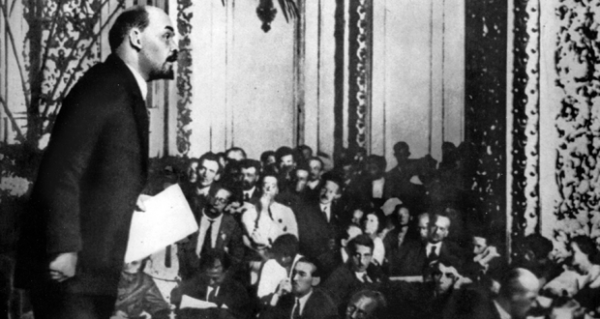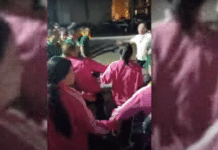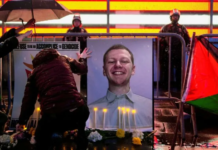By Per-Ake Westerlund, member of Rättvisepartiet Socialisterna (CWI Sweden)
Within six months, the Communist International, the Comintern, had one million members.
Socialists today need to study and learn from history. The Comintern showed the strength of the working class in a revolutionary time, underlining the need for revolutionary mass parties to end the war and exploitation of capitalism.
Right-wing politicians and capitalist commentators use the degeneration of the Russian Revolution into a dictatorship under Stalin as an argument against the Comintern and socialism. But the fact is that it was precisely the defeats of the revolutions in other countries that laid the foundation for Stalinism. The political and organisational weaknesses of the newly formed Communist Parties and of the Comintern as a whole opened the way to counter-revolution and isolated the Soviet Union. Stalin then launched the slogan of “socialism in one country” and established his and the bureaucracy’s power in the Soviet Union with increasingly bloody purges. The fact that Stalin in 1943 officially dissolved the Comintern underlines the contradiction between Stalinism and the policies pursued when the Comintern was formed.
The collapse of the Second International
The labour movement has always been international. This is in contrast to the bourgeois classes, whose base is the nation states, from the exercise of power within the country to conducting wars and conquering colonies. The working class, on the other hand, has common interests across national borders, summarised by Marx and Engels in the Communist Manifesto’s final appeal, “Worker’s in all countries, unite”. It was, and still is, time for the majority, the working class, to establish its own social system, socialism.

The First International was founded in 1864 and contained several different tendencies, from Marxists to anarchists and trade union leaders. The Second International was formed in 1889 and consisted of rapidly growing social-democratic worker’s parties that essentially defended Marx’s revolutionary ideas. In this international, the Russian Social Democrats, whose left wing was the Bolsheviks under Lenin, were included.
The Second International collapsed when World War I broke out. Despite recurring declarations from all parties involved in the war, almost all party leaders chose to support their own country’s warfare. The German Social Democrats organised mass demonstrations against the war as late as the week before the outbreak of war, but still its parliamentarians voted for the war credits. In country after country, the Social-Democratic parties agreed to “class peace” with bourgeois governments and monarchies.
The capitulation of the Social Democratic parties shocked both Lenin and Rosa Luxemburg, who was a leader of the left within the German Social Democrats.
Zimmerwald
Lenin’s conclusion was that the collapsed Second International must be replaced by a new, Third International. A first step was to gather war opponents in the Social Democratic parties to a conference in Zimmerwald in Switzerland, September 5-8, 1915. Thirty seven representatives from eleven countries participated, most of whom came from the left of the Social Democratic parties. But official representatives came from the Bolsheviks and for example the Italian Socialist Party. The agreed statement proposed by Leon Trotsky condemned the war and its threat to all humanity. The manifesto pointed out the responsibility of the parties that supported the war, and called for class struggle against the war, for socialism.
At the initiative of Lenin, the Zimmerwald left, including the representatives of the Swedish Social Democratic Youth League and the party left-wing, Zäta Höglund and Ture Nerman, gathered immediately afterwards. A secretariat was established in Stockholm, where a final Zimmerwald conference was held in September 1917.
Zimmerwald consisted of mostly relatively small groups, left-wing minorities and those in opposition to the war. But these relations of power were completely changed by the Russian Revolution. In February 1917, the almighty Tsar was overthrown, and in October, the workers’ democratic councils, the Soviets, took power under the leadership of the Bolshevik Party. In the first resolution of the October Revolution, immediate peace was called for. World War I had taken the lives of nearly 10 million combatants and 6-7 million civilians.
An internationalist revolution
Both the Russian Revolution and the Bolshevik Party were strongly internationalist. The whole perspective after the workers took power in Russia was that the Russian Revolution was the beginning of a series of international revolutions. The experience from Russia was also that the alternative to a complete takeover of power of the working class was the most brutal reaction, shown by the dictatorship General Kornilov tried to establish in August 1917.
Among workers and oppressed throughout the world, the Russian Revolution sparked the hope of liberation from the war, need, and all oppression. Hundreds of thousands of activists in the labour movement internationally began to consider themselves Bolsheviks. Already on January 24, 1918, a first conference was held with international participants, including from the Swedish Left Social Democratic Party SSV.
Internationalism was also a result of the war. In Russia, there were two million prisoners of war, many of whom returned to their homeland as supporters of the revolution. Newspapers and bulletins were published in a variety of languages. When the counter-revolution took to arms and foreign armies invaded Russia, 50,000 joined from outside Tsar-Russia as volunteers in the Red Army.
When the revolution broke out and the emperor was overthrown in Germany in November 1918, the question of a new international became even more urgent. The Bolsheviks had changed its party name from Social Democrats to Communists to separate themselves from the pro-war parties. New communist parties followed in other countries: Austria November 3, Hungary November 24, Poland December 15 and on January 19 also in Argentina. Most important of the new parties was the German Communist Party KPD, which was formed in the New Year 1919, with Rosa Luxemburg and Karl Liebknecht in the leadership.
After the November Revolution, when Rosa Luxemburg was released from prison – she had been convicted for her resistance to the war – she concluded that the Russian revolution had shown the way and a party had to be formed. In December, a representative of the German Communists, Eduard Fuchs, came to Moscow for discussions. In a security coded message, Rosa Luxemburg greeted Lenin: “May God grant that the coming year will fulfill all our wishes. All the best! Uncle will report on our life and doings, meantime I press your hand”.
But just over two weeks after the formation of the KPD, Liebknecht and Luxemburg were murdered by the Freicorps organised by the Social Democratic Police Minister Noske.
The first Congress
Without knowledge of the murders, on January 24, the Russian party and eight new Communist Parties sent out an invitation to a founding conference for a new international. The text, written by Trotsky, showed how the alternatives stood between the bloody dictatorships of the generals or the dictatorship of the workers to “build a new world on the ruins of the countries destroyed by the war.” The invitation underlined how the social chauvinists – those social democratic parties that supported the war – used arms against the working class, both in Russia and Germany.
39 groups and parties were invited. From Norway, Italy and Serbia, it was mass parties, in Sweden, Bulgaria and the Netherlands major left-wing splits from the Social Democrats.
The congress was conducted during the ongoing civil war in Russia, with revolution and counter-revolution on the agenda in much of Europe. Several delegates could not make it to Moscow, but among those who were in place was Otto Grimlund from SSV. Ture Nerman later described in his book about the Comintern:
“The opening took place on March 2 at 6pm in the courthouse in the Kremlin. The long hall was decorated with red tablecloths with inscriptions: “Long live Third International!” On the walls were pictures of revolutionary leaders in different countries and on a wall the victims of the proletarian freedom struggle: Karl Liebknecht, Rosa Luxemburg and others. It was Lenin, who opened the historic gathering, and his stenographically recorded speech gives the eloquent mood of the day in the core of the new world movement:
“On behalf of the Russian CP’s Central Committee, I open the first international communist congress. First I ask everyone present to rise in memory of the Third International’s best representatives, Karl Liebknecht and Rosa Luxemburg. (A minute of silence.)
“Comrades! Our gathering is of far-reaching world-historical significance. It proves that the illusions of bourgeois democracy are crushed. ”
Preparatory of founding congress?
At the congress there were 34 representatives with 56 votes. For example, Eberlein who was the only participant from the KPD had 5 votes. Otto Grimlund from SSV had three votes, as did the representative from the Norwegian Labour Party and the three participants from the Finnish Communist Party. In addition, 19 delegates attended with an advisory vote.
Hugo Eberlein brought with him a directive from the KPD that the conference should be seen as preparatory and that he thus should not vote in order to form a new international there and then. Lenin and the Bolsheviks explained that in that case they would be prepared to postpone the decision. But during the conference, more and more people argued that the step must be taken.
Otto Grimlund from the Swedish SSV was one of them and received an answer from Eberlein:
“Real communist parties exist only in a few countries. In most, they have been created in the last few weeks, in several countries where there are communists today, there is still no organisation. I am surprised when the representative of Sweden calls for the founding of the Third International and must admit that in Sweden there is no purely communist organisation but only a large communist group within the Swedish Social Democratic Party. ”
Grimlund in turn “recalled that his party energetically defended the Zimmerwald and the Russian Bolshevik revolution.” (quotes from Ture Nerman’s book, Kommunisterna)
When the Congress took the decision to form the Third International (Comintern), Eberlein explained that he still doubted whether it was right, but that he would now try to get his comrades in Germany to join as soon as possible.
Appeal for worker’s councils
The Congress saw the formation of the International as a crucial step to a federal socialist world republic. A society in total contrast to the slaughter of the world war and the dictatorships established. The white terror was branded in a special resolution: “The Tsarist government shot and hanged workers, organised pogroms of Jews, destroyed anything living; the Austrian monarchy drowned the indignation of the Ukrainian and Czech peasants and workers in blood, the British bourgeoisie butchered the best representatives of the Irish people…”
Based on the experience of the Russian revolution, the importance of worker’s democracy based on democratic councils was emphasised:
“On the basis of these thesis and the reports made by the delegates from the different countries, the Congress of the Communist International declares that the chief task of the Communist Parties in all countries where Soviet government has not yet been established, is as follows:
1) to explain to the broad mass of the workers the historic significance and the political and historical necessity of the new, proletarian, democracy which must replace bourgeois democracy and the parliamentary system;
2) to extend the organization of Soviets among the workers in all branches of industry, among the soldiers in the Army and the sailors in the Navy and also among farm laborers and poor peasants;
3) to build a stable Communist majority inside the Soviets.”
1919 – Year of revolutions
That year, 1919, the bourgeoisie’s power and capitalism hung by a very fragile thread. Just a few weeks after Congress, the Hungarian workers took power and shortly afterwards, the workers in Bavaria established a Soviet republic. The latter lasted from April 7 to May 3, while the Hungarian fell on August 1. Both were crushed in blood.
1919 was also a year of the general strikes, with a truly global worker’s struggle and radicalisation. Massive general strikes were organized in, among others, Scotland, Peru and the newly formed Yugoslavia. Whole cities were shaken or taken over by the labor struggle, such as Seattle, Winnipeg, Limerick, Barcelona, Glasgow, Belfast, Zurich and many more.
The Communist parties and the entire Comintern grew rapidly and in the autumn of 1919 had half a million members outside the former Tsar-Russia. The following year, the German Independent Social Democratic Party (a left split from the Social Democrats) split and the KPD received 300,000 new members. The majority of the French Socialist Party joined the Comintern (150,000 of 200,000 members). Large communist parties emerged in Czechoslovakia and Bulgaria.
The Comintern also differed from the Second International in the emphasis of the colonial revolution. At the Second Congress in 1920, 30 delegates from Asia, including from nations and peoples who were oppressed during the tsar’s rule, participated.
The optimistic perspective of 1919, on the rapid takeover of power across Europe and the world, was extinguished by the victories of the counter-revolution. Revolutions and strikes showed the strength of the working class and could force concessions, but they did not lead the workers to take power.
The need for revolutionary parties
The explanation was already given at the Comintern founding conference 100 years ago. In the manifesto that was prepared by Trotsky and adopted unanimously, the crucial importance of the revolutionary party is emphasized:
“If the First International predicted the future course of development and indicated the roads it would take, if the Second International rallied and organised millions of proletarians, then the Third International is the International of open mass struggle, the International of revolutionary realization, the International of action.
The bourgeois world order has been sufficiently lashed by socialist criticism. The task of the international communist party consists in overthrowing that order and erecting in its place the edifice of the socialist order. ”
The new Communist parties lacked the Bolshevik Party’s long experience. Thousands of active workers had been schooled by the party’s politics and struggle. The leadership under Lenin and Trotsky understood that the revolution could not stop halfway. The Party’s method of “patiently explaining” what was needed in 1917, in parallel with concrete slogans such as “Peace, Bread, Earth” and “All Power to the Soviets” was matched by the workers’ own experiences and led to mass influx into the party.
In other countries, Communist parties were missing or they were built up after the revolutions. In 1919 there was the opportunity to take power in several countries. In Germany, the revolution was lost in the autumn of 1923, which eventually opened the way for the worst reaction.
With the isolation of the Soviet Union and the hardening grip of Stalinism, the Comintern lost much of its appeal, despite the fact that the Communist parties stubbornly and mistakenly argued that they were following in the tracks of Lenin and the Russian Revolution. The real Marxists were the internationalists who, with Leon Trotsky, fought against Stalinism.




